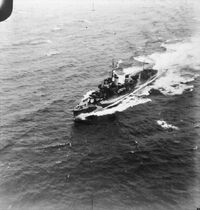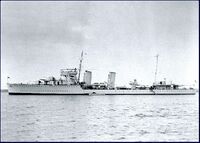Judge King (talk | contribs) mNo edit summary |
Judge King (talk | contribs) m (→Royal Navy) |
||
| (7 intermediate revisions by the same user not shown) | |||
| Line 1: | Line 1: | ||
| − | The '''''A''-class''' was a flotilla of eight destroyers built for the [[Royal Navy]] as part of the 1927 naval program. A ninth ship, HMS ''Codrington'', was built to an enlarged design to act as the flotilla leader. |
+ | [[Image:HMS_Active_(H41).jpg|thumb|right|200px|HMS ''Active'' (H41) underway in the Gibraltar Straits on May 26th, 1944.]]The '''''A''-class''' was a flotilla of eight destroyers built for the [[Royal Navy]] as part of the 1927 naval program. A ninth ship, HMS ''Codrington'', was built to an enlarged design to act as the flotilla leader. Eight similar ships were built for the [[Royal Canadian Navy]]. |
==Design== |
==Design== |
||
| − | The A |
+ | The ''A''-class were an Admiralty standard design based on the 1926 prototypes [[HMS Amazon (D39)|HMS ''Amazon'']] and [[HMS Ambuscade (D38)|HMS ''Ambuscade'']]. It was intended that the following alterations be made from the prototypes: |
*The guns were to be true Quick Firing (QF) pieces with full length shields, those in Amazon and Ambuscade were of the Breech Loading (BL) type, with two-part ammunition. |
*The guns were to be true Quick Firing (QF) pieces with full length shields, those in Amazon and Ambuscade were of the Breech Loading (BL) type, with two-part ammunition. |
||
*'B' gun was to be carried on a High-Angle (HA) mounting giving 60° elevation |
*'B' gun was to be carried on a High-Angle (HA) mounting giving 60° elevation |
||
| Line 14: | Line 14: | ||
===Canadian Ships=== |
===Canadian Ships=== |
||
| − | The |
+ | [[Image:HMCS_Saguenay_(D79).jpg|thumb|right|200px|Canadian destroyer HMCS ''Saguenay'' (D79) circa 1932-1934.]]The eight [[Canada|Canadian]] ships were designed to be of a similar performance and specification to the [[British Empire|British]] ships to allow them to tactically combine. They had their bows strengthened with heavier plating to enable them to perform in areas with ice, with a large metacentric height to allow for the build-up of ice and snow on the upperworks. The ships were built by John I. Thornycroft & Company in Woolston, Hampshire and had the broad, slab-sided funnels characteristic of that builder. |
| − | |||
==Unit Run== |
==Unit Run== |
||
===Royal Navy=== |
===Royal Navy=== |
||
| − | *HMS '' |
+ | *HMS ''Codrington'' (D65) - flotilla leader |
| − | *HMS '' |
+ | *HMS ''Active'' (H14) |
| − | *HMS '' |
+ | *HMS ''Antelope'' (H36) |
| − | *HMS ''Anthony'' |
+ | *HMS ''Anthony'' (H40) |
| − | *HMS '' |
+ | *HMS ''Ardent'' (H41) |
| − | *HMS '' |
+ | *HMS ''Acasta'' (H09) |
| − | *HMS ''Arrow'' |
+ | *HMS ''Arrow'' (H42) |
| − | *HMS ''Acheron'' |
+ | *HMS ''Acheron'' (H48) |
| − | *HMS '' |
+ | *HMS ''Achates'' (H12) |
===Royal Canadian Navy=== |
===Royal Canadian Navy=== |
||
| − | *HMCS ''Saguenay'' ( |
+ | *HMCS ''Saguenay'' (D180) |
| − | *HMCS ''Skeena'' ( |
+ | *HMCS ''Skeena'' (D181) |
| − | *HMCS '' |
+ | *HMCS ''Schyan'' (D182) |
| − | *HMCS '' |
+ | *HMCS ''Severn'' (D183) |
| + | *HMCS ''Sunwapta'' (D184) |
||
| + | *HMCS ''Scoudouc'' (D185) |
||
| + | *HMCS ''Sakami'' (D186) |
||
| + | *HMCS ''Shashiskau'' (D187) |
||
[[Category:British Empire]] |
[[Category:British Empire]] |
||
[[Category:Canada]] |
[[Category:Canada]] |
||
Latest revision as of 19:31, 4 June 2018

HMS Active (H41) underway in the Gibraltar Straits on May 26th, 1944.
The A-class was a flotilla of eight destroyers built for the Royal Navy as part of the 1927 naval program. A ninth ship, HMS Codrington, was built to an enlarged design to act as the flotilla leader. Eight similar ships were built for the Royal Canadian Navy.
Design[]
The A-class were an Admiralty standard design based on the 1926 prototypes HMS Amazon and HMS Ambuscade. It was intended that the following alterations be made from the prototypes:
- The guns were to be true Quick Firing (QF) pieces with full length shields, those in Amazon and Ambuscade were of the Breech Loading (BL) type, with two-part ammunition.
- 'B' gun was to be carried on a High-Angle (HA) mounting giving 60° elevation
- The torpedo tubes were to be quadruple instead of triple
- Asdic (sonar), depth charges and high-speed destroyer minesweeps were to be carried
- The separate cruising steam turbines were to be replaced by adding a cruising stage to the main turbine
- A petrol generator was to be fitted, so that electric light and services could be provided when steam was down in harbor
- High temperature and pressure boilers (500 psi, 750 ° F) by Parsons Marine Steam Turbines for weight and economy savings.
In the event, the HA mounting was never fitted, along with the ASDIC and most of the depth charges. The class were 200 tons heavier than the 1926 prototypes yet the only major improvement were the quadruple tubes. Speed was disappointing, being 35 knots (65 km/h) with a deep load maximum of only 31 knots (57 km/h).
Canadian Ships[]

Canadian destroyer HMCS Saguenay (D79) circa 1932-1934.
The eight Canadian ships were designed to be of a similar performance and specification to the British ships to allow them to tactically combine. They had their bows strengthened with heavier plating to enable them to perform in areas with ice, with a large metacentric height to allow for the build-up of ice and snow on the upperworks. The ships were built by John I. Thornycroft & Company in Woolston, Hampshire and had the broad, slab-sided funnels characteristic of that builder.
Unit Run[]
[]
- HMS Codrington (D65) - flotilla leader
- HMS Active (H14)
- HMS Antelope (H36)
- HMS Anthony (H40)
- HMS Ardent (H41)
- HMS Acasta (H09)
- HMS Arrow (H42)
- HMS Acheron (H48)
- HMS Achates (H12)
[]
- HMCS Saguenay (D180)
- HMCS Skeena (D181)
- HMCS Schyan (D182)
- HMCS Severn (D183)
- HMCS Sunwapta (D184)
- HMCS Scoudouc (D185)
- HMCS Sakami (D186)
- HMCS Shashiskau (D187)